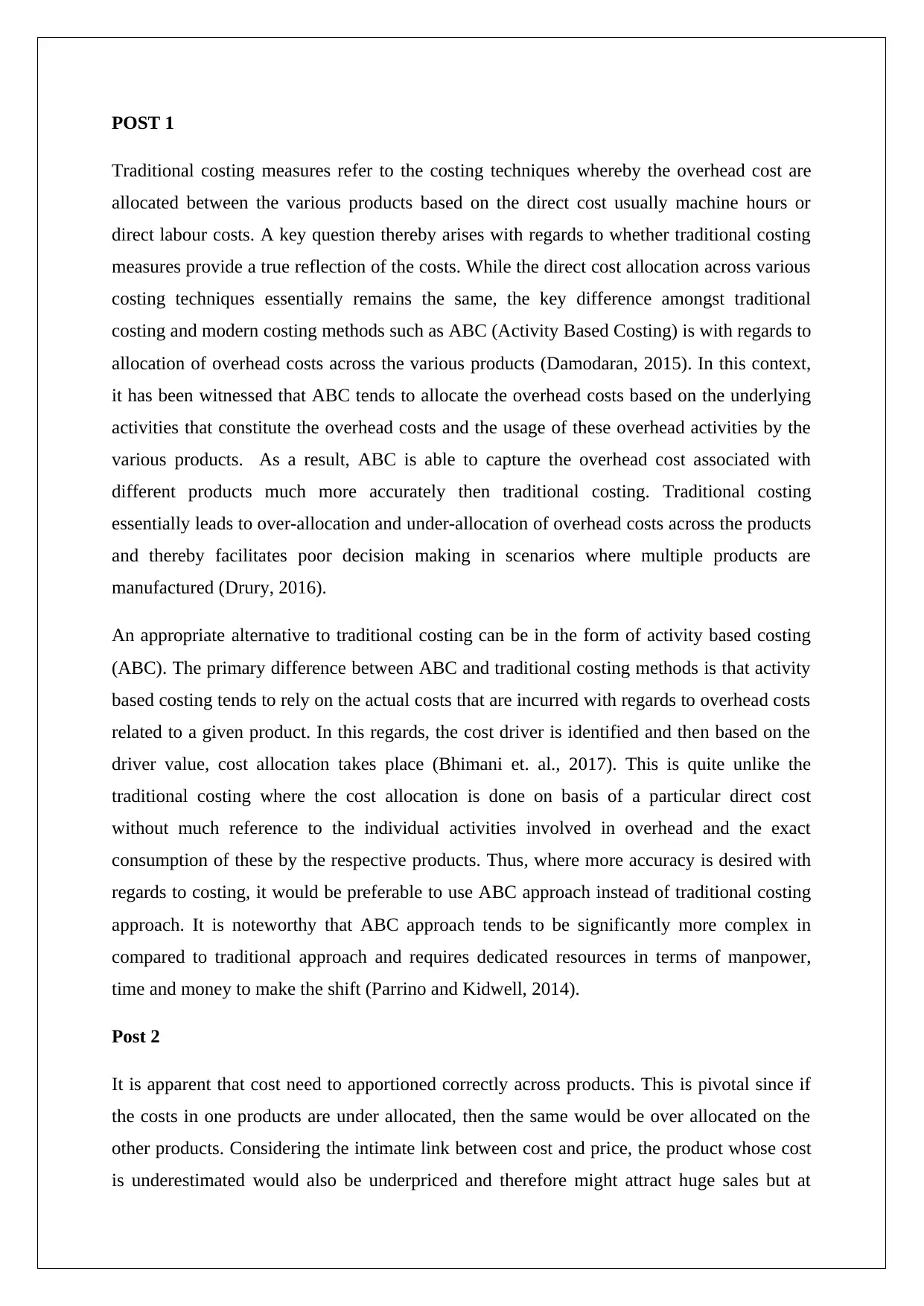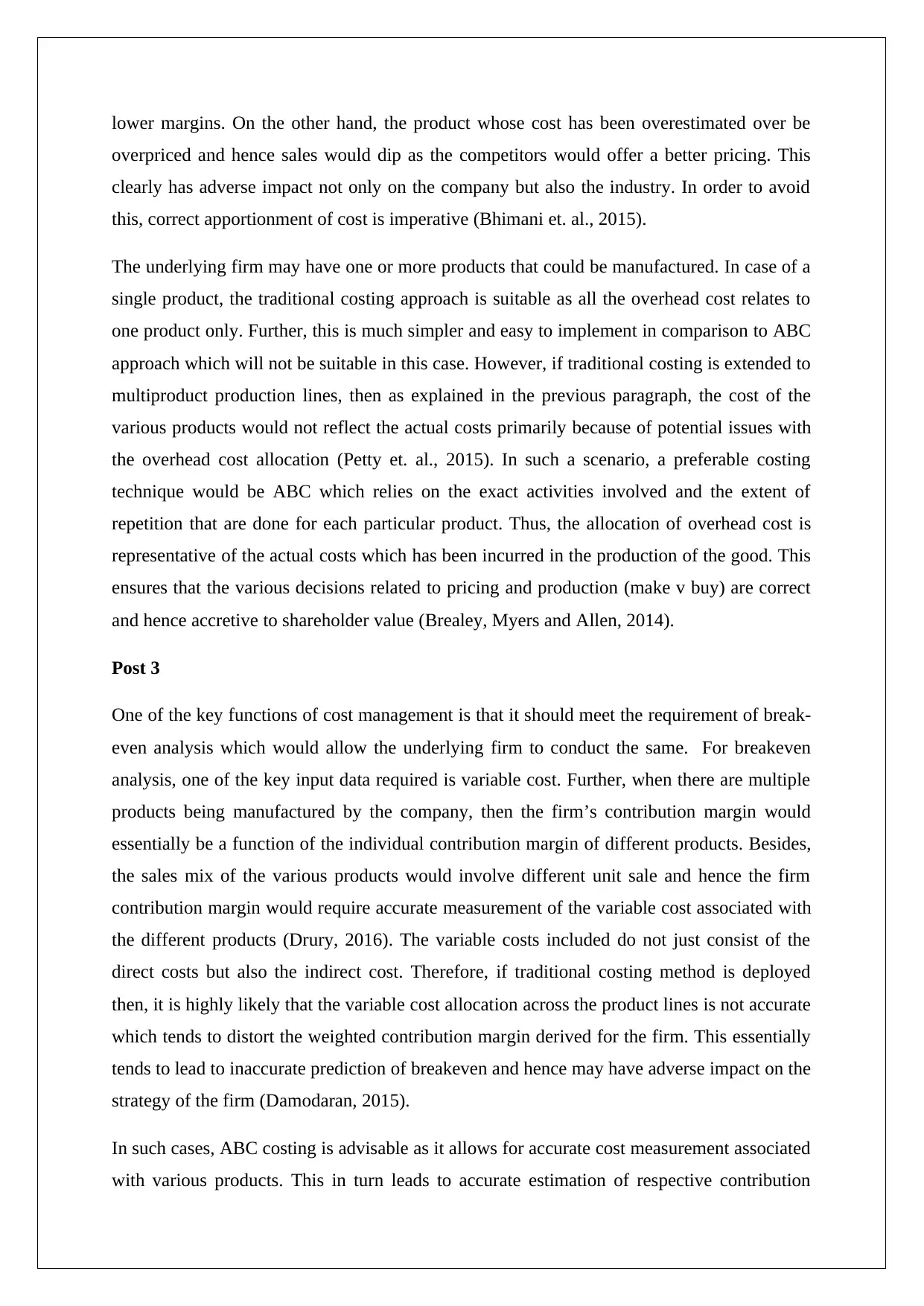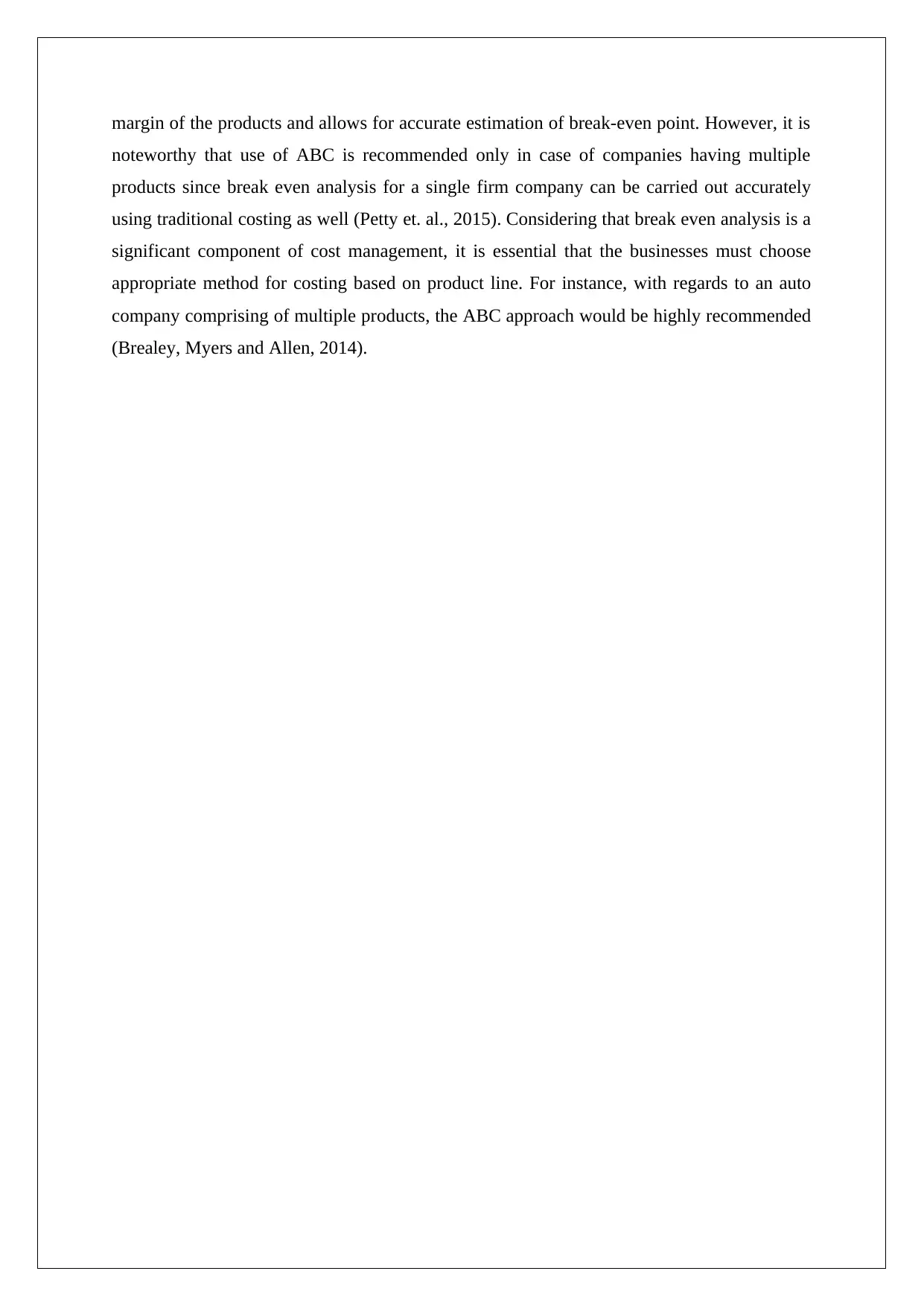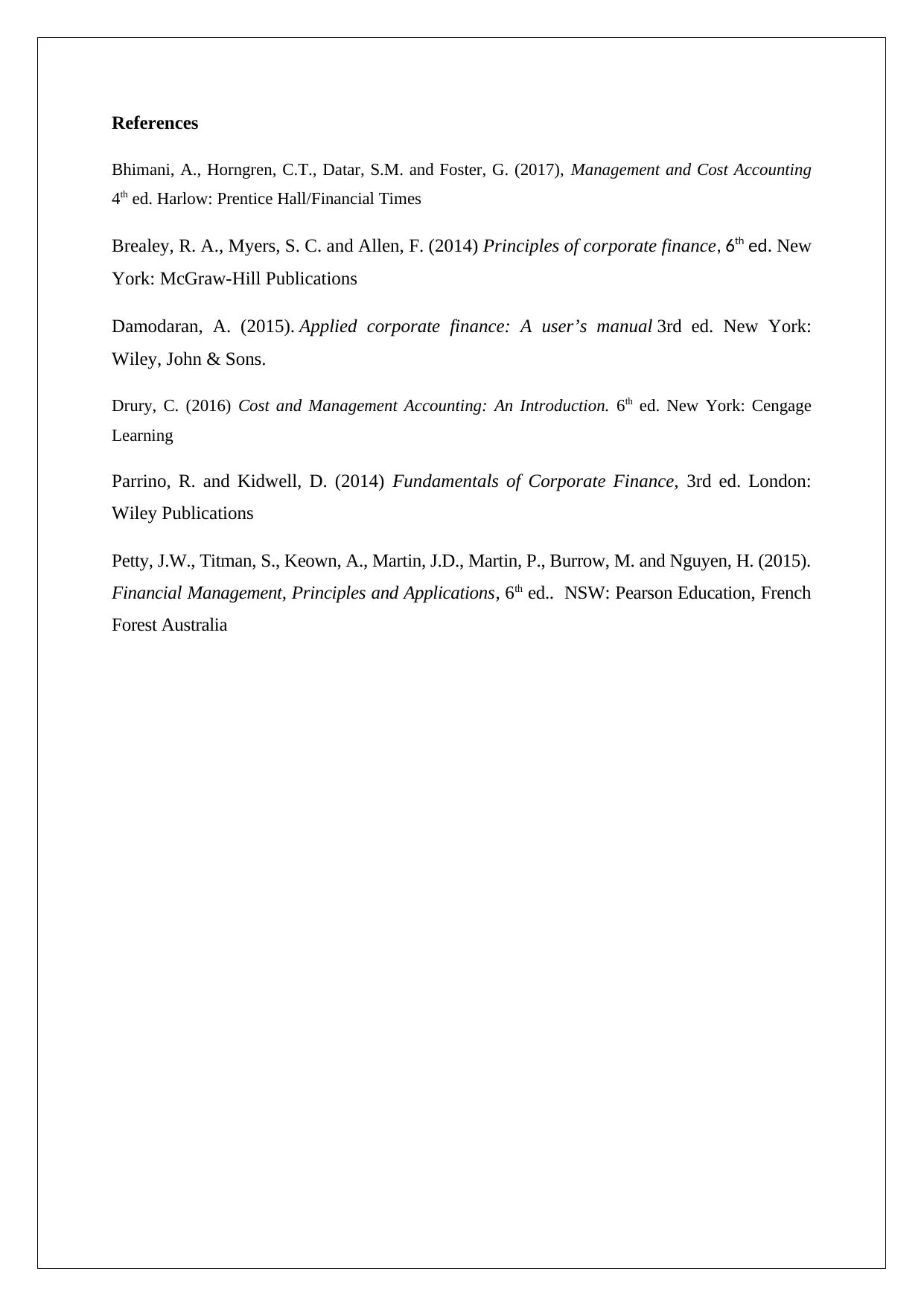Analysis of Traditional Costing Methods & ABC in Finance
VerifiedAdded on 2023/05/31
|5
|1275
|311
Discussion Board Post
AI Summary
This discussion post analyzes traditional costing methods in comparison to Activity-Based Costing (ABC) within the context of financial decision-making. It highlights that traditional costing allocates overhead costs based on direct costs, potentially leading to inaccurate cost allocation across various products, unlike ABC, which allocates costs based on underlying activities. The post emphasizes that while traditional costing is suitable for single-product scenarios due to its simplicity, ABC is preferable for multi-product environments where accurate cost apportionment is critical for pricing, production, and breakeven analysis. Inaccurate cost allocation can lead to under or overpricing, impacting sales and profitability, whereas ABC provides a more accurate representation of actual costs, aiding in better strategic decisions. The post also underscores the importance of accurate variable cost measurement for breakeven analysis, advocating for ABC in companies with multiple products to avoid distortions in contribution margins and ensure reliable predictions.

FINANCE
STUDENT ID:
[Pick the date]
STUDENT ID:
[Pick the date]
Paraphrase This Document
Need a fresh take? Get an instant paraphrase of this document with our AI Paraphraser

POST 1
Traditional costing measures refer to the costing techniques whereby the overhead cost are
allocated between the various products based on the direct cost usually machine hours or
direct labour costs. A key question thereby arises with regards to whether traditional costing
measures provide a true reflection of the costs. While the direct cost allocation across various
costing techniques essentially remains the same, the key difference amongst traditional
costing and modern costing methods such as ABC (Activity Based Costing) is with regards to
allocation of overhead costs across the various products (Damodaran, 2015). In this context,
it has been witnessed that ABC tends to allocate the overhead costs based on the underlying
activities that constitute the overhead costs and the usage of these overhead activities by the
various products. As a result, ABC is able to capture the overhead cost associated with
different products much more accurately then traditional costing. Traditional costing
essentially leads to over-allocation and under-allocation of overhead costs across the products
and thereby facilitates poor decision making in scenarios where multiple products are
manufactured (Drury, 2016).
An appropriate alternative to traditional costing can be in the form of activity based costing
(ABC). The primary difference between ABC and traditional costing methods is that activity
based costing tends to rely on the actual costs that are incurred with regards to overhead costs
related to a given product. In this regards, the cost driver is identified and then based on the
driver value, cost allocation takes place (Bhimani et. al., 2017). This is quite unlike the
traditional costing where the cost allocation is done on basis of a particular direct cost
without much reference to the individual activities involved in overhead and the exact
consumption of these by the respective products. Thus, where more accuracy is desired with
regards to costing, it would be preferable to use ABC approach instead of traditional costing
approach. It is noteworthy that ABC approach tends to be significantly more complex in
compared to traditional approach and requires dedicated resources in terms of manpower,
time and money to make the shift (Parrino and Kidwell, 2014).
Post 2
It is apparent that cost need to apportioned correctly across products. This is pivotal since if
the costs in one products are under allocated, then the same would be over allocated on the
other products. Considering the intimate link between cost and price, the product whose cost
is underestimated would also be underpriced and therefore might attract huge sales but at
Traditional costing measures refer to the costing techniques whereby the overhead cost are
allocated between the various products based on the direct cost usually machine hours or
direct labour costs. A key question thereby arises with regards to whether traditional costing
measures provide a true reflection of the costs. While the direct cost allocation across various
costing techniques essentially remains the same, the key difference amongst traditional
costing and modern costing methods such as ABC (Activity Based Costing) is with regards to
allocation of overhead costs across the various products (Damodaran, 2015). In this context,
it has been witnessed that ABC tends to allocate the overhead costs based on the underlying
activities that constitute the overhead costs and the usage of these overhead activities by the
various products. As a result, ABC is able to capture the overhead cost associated with
different products much more accurately then traditional costing. Traditional costing
essentially leads to over-allocation and under-allocation of overhead costs across the products
and thereby facilitates poor decision making in scenarios where multiple products are
manufactured (Drury, 2016).
An appropriate alternative to traditional costing can be in the form of activity based costing
(ABC). The primary difference between ABC and traditional costing methods is that activity
based costing tends to rely on the actual costs that are incurred with regards to overhead costs
related to a given product. In this regards, the cost driver is identified and then based on the
driver value, cost allocation takes place (Bhimani et. al., 2017). This is quite unlike the
traditional costing where the cost allocation is done on basis of a particular direct cost
without much reference to the individual activities involved in overhead and the exact
consumption of these by the respective products. Thus, where more accuracy is desired with
regards to costing, it would be preferable to use ABC approach instead of traditional costing
approach. It is noteworthy that ABC approach tends to be significantly more complex in
compared to traditional approach and requires dedicated resources in terms of manpower,
time and money to make the shift (Parrino and Kidwell, 2014).
Post 2
It is apparent that cost need to apportioned correctly across products. This is pivotal since if
the costs in one products are under allocated, then the same would be over allocated on the
other products. Considering the intimate link between cost and price, the product whose cost
is underestimated would also be underpriced and therefore might attract huge sales but at

lower margins. On the other hand, the product whose cost has been overestimated over be
overpriced and hence sales would dip as the competitors would offer a better pricing. This
clearly has adverse impact not only on the company but also the industry. In order to avoid
this, correct apportionment of cost is imperative (Bhimani et. al., 2015).
The underlying firm may have one or more products that could be manufactured. In case of a
single product, the traditional costing approach is suitable as all the overhead cost relates to
one product only. Further, this is much simpler and easy to implement in comparison to ABC
approach which will not be suitable in this case. However, if traditional costing is extended to
multiproduct production lines, then as explained in the previous paragraph, the cost of the
various products would not reflect the actual costs primarily because of potential issues with
the overhead cost allocation (Petty et. al., 2015). In such a scenario, a preferable costing
technique would be ABC which relies on the exact activities involved and the extent of
repetition that are done for each particular product. Thus, the allocation of overhead cost is
representative of the actual costs which has been incurred in the production of the good. This
ensures that the various decisions related to pricing and production (make v buy) are correct
and hence accretive to shareholder value (Brealey, Myers and Allen, 2014).
Post 3
One of the key functions of cost management is that it should meet the requirement of break-
even analysis which would allow the underlying firm to conduct the same. For breakeven
analysis, one of the key input data required is variable cost. Further, when there are multiple
products being manufactured by the company, then the firm’s contribution margin would
essentially be a function of the individual contribution margin of different products. Besides,
the sales mix of the various products would involve different unit sale and hence the firm
contribution margin would require accurate measurement of the variable cost associated with
the different products (Drury, 2016). The variable costs included do not just consist of the
direct costs but also the indirect cost. Therefore, if traditional costing method is deployed
then, it is highly likely that the variable cost allocation across the product lines is not accurate
which tends to distort the weighted contribution margin derived for the firm. This essentially
tends to lead to inaccurate prediction of breakeven and hence may have adverse impact on the
strategy of the firm (Damodaran, 2015).
In such cases, ABC costing is advisable as it allows for accurate cost measurement associated
with various products. This in turn leads to accurate estimation of respective contribution
overpriced and hence sales would dip as the competitors would offer a better pricing. This
clearly has adverse impact not only on the company but also the industry. In order to avoid
this, correct apportionment of cost is imperative (Bhimani et. al., 2015).
The underlying firm may have one or more products that could be manufactured. In case of a
single product, the traditional costing approach is suitable as all the overhead cost relates to
one product only. Further, this is much simpler and easy to implement in comparison to ABC
approach which will not be suitable in this case. However, if traditional costing is extended to
multiproduct production lines, then as explained in the previous paragraph, the cost of the
various products would not reflect the actual costs primarily because of potential issues with
the overhead cost allocation (Petty et. al., 2015). In such a scenario, a preferable costing
technique would be ABC which relies on the exact activities involved and the extent of
repetition that are done for each particular product. Thus, the allocation of overhead cost is
representative of the actual costs which has been incurred in the production of the good. This
ensures that the various decisions related to pricing and production (make v buy) are correct
and hence accretive to shareholder value (Brealey, Myers and Allen, 2014).
Post 3
One of the key functions of cost management is that it should meet the requirement of break-
even analysis which would allow the underlying firm to conduct the same. For breakeven
analysis, one of the key input data required is variable cost. Further, when there are multiple
products being manufactured by the company, then the firm’s contribution margin would
essentially be a function of the individual contribution margin of different products. Besides,
the sales mix of the various products would involve different unit sale and hence the firm
contribution margin would require accurate measurement of the variable cost associated with
the different products (Drury, 2016). The variable costs included do not just consist of the
direct costs but also the indirect cost. Therefore, if traditional costing method is deployed
then, it is highly likely that the variable cost allocation across the product lines is not accurate
which tends to distort the weighted contribution margin derived for the firm. This essentially
tends to lead to inaccurate prediction of breakeven and hence may have adverse impact on the
strategy of the firm (Damodaran, 2015).
In such cases, ABC costing is advisable as it allows for accurate cost measurement associated
with various products. This in turn leads to accurate estimation of respective contribution
⊘ This is a preview!⊘
Do you want full access?
Subscribe today to unlock all pages.

Trusted by 1+ million students worldwide

margin of the products and allows for accurate estimation of break-even point. However, it is
noteworthy that use of ABC is recommended only in case of companies having multiple
products since break even analysis for a single firm company can be carried out accurately
using traditional costing as well (Petty et. al., 2015). Considering that break even analysis is a
significant component of cost management, it is essential that the businesses must choose
appropriate method for costing based on product line. For instance, with regards to an auto
company comprising of multiple products, the ABC approach would be highly recommended
(Brealey, Myers and Allen, 2014).
noteworthy that use of ABC is recommended only in case of companies having multiple
products since break even analysis for a single firm company can be carried out accurately
using traditional costing as well (Petty et. al., 2015). Considering that break even analysis is a
significant component of cost management, it is essential that the businesses must choose
appropriate method for costing based on product line. For instance, with regards to an auto
company comprising of multiple products, the ABC approach would be highly recommended
(Brealey, Myers and Allen, 2014).
Paraphrase This Document
Need a fresh take? Get an instant paraphrase of this document with our AI Paraphraser

References
Bhimani, A., Horngren, C.T., Datar, S.M. and Foster, G. (2017), Management and Cost Accounting
4th ed. Harlow: Prentice Hall/Financial Times
Brealey, R. A., Myers, S. C. and Allen, F. (2014) Principles of corporate finance, 6th ed. New
York: McGraw-Hill Publications
Damodaran, A. (2015). Applied corporate finance: A user’s manual 3rd ed. New York:
Wiley, John & Sons.
Drury, C. (2016) Cost and Management Accounting: An Introduction. 6th ed. New York: Cengage
Learning
Parrino, R. and Kidwell, D. (2014) Fundamentals of Corporate Finance, 3rd ed. London:
Wiley Publications
Petty, J.W., Titman, S., Keown, A., Martin, J.D., Martin, P., Burrow, M. and Nguyen, H. (2015).
Financial Management, Principles and Applications, 6th ed.. NSW: Pearson Education, French
Forest Australia
Bhimani, A., Horngren, C.T., Datar, S.M. and Foster, G. (2017), Management and Cost Accounting
4th ed. Harlow: Prentice Hall/Financial Times
Brealey, R. A., Myers, S. C. and Allen, F. (2014) Principles of corporate finance, 6th ed. New
York: McGraw-Hill Publications
Damodaran, A. (2015). Applied corporate finance: A user’s manual 3rd ed. New York:
Wiley, John & Sons.
Drury, C. (2016) Cost and Management Accounting: An Introduction. 6th ed. New York: Cengage
Learning
Parrino, R. and Kidwell, D. (2014) Fundamentals of Corporate Finance, 3rd ed. London:
Wiley Publications
Petty, J.W., Titman, S., Keown, A., Martin, J.D., Martin, P., Burrow, M. and Nguyen, H. (2015).
Financial Management, Principles and Applications, 6th ed.. NSW: Pearson Education, French
Forest Australia
1 out of 5
Related Documents
Your All-in-One AI-Powered Toolkit for Academic Success.
+13062052269
info@desklib.com
Available 24*7 on WhatsApp / Email
![[object Object]](/_next/static/media/star-bottom.7253800d.svg)
Unlock your academic potential
Copyright © 2020–2025 A2Z Services. All Rights Reserved. Developed and managed by ZUCOL.





